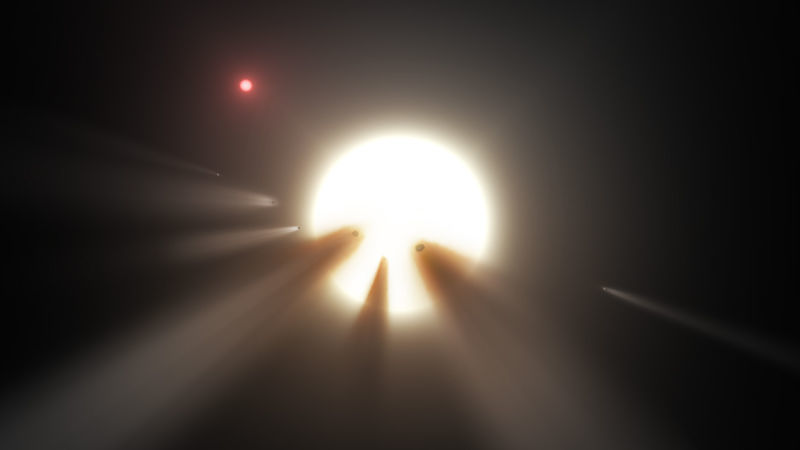Saturn’s icy moon Enceladus is the latest target in the perennial excitement around finding extraterrestrial life. Its warm subterranean ocean is thought to contain all the right ingredients to harbour alien microbes, which would arguably be the biggest scientific discovery in human history. While finding microbes — even biosignatures on places like Mars — would be incredible, perhaps we’re overlooking something critical in the search for life in our solar system, specifically intelligent life. Take that, tiny microbes.
Image: NASA, JPL-Caltech
A new paper from astronomer Jason Wright, Prior Indigenous Technological Species, poses the question: Have we exhausted our options in searching for signs of extremely old, intelligent life? Contrary to what this outlet or this outlet or this outlet claims, Wright’s paper does not offer any evidence or proof of an ancient alien civilisation — instead, it ruminates on whether or not there’s a chance we’re overlooking some critical clue in our hunt.
“There is zero evidence for any prior indigenous technological civilisations,” Wright told Gizmodo. “My paper asks, have we completely foreclosed the possibility, or is there a chance that there could be some evidence we overlooked? [And] if we have overlooked something and we find it in the future, what are the chances it could have come from a prior indigenous technological species versus an interstellar one?”
Wright suggests the idea of looking for “technosignatures” within our solar system — traces left behind from life that hypothetically would have existed millions to billions years ago. While Mars has long been a favourite in the hunt for signs of extinct life, there’s growing evidence that Venus could have been habitable in the very distant past — some models suggest that in the distant past, the planet had liquid water oceans for up to two billion years, which is long enough for life to evolve.
Technosignatures, however, are a bit different from the “biosignatures” astronomers will be looking for on places like Mars or eventually, within the TRAPPIST-1 system.
“A ‘biosignature’ is any sort of indication that life exists somewhere,” Wright explained. “Astrobiologists hope to look for biosignatures in the atmospheres of other planets on on Mars or Europa, things like oxygen or other products of biology and metabolism. A ‘technosignature’ is evidence of technology.” An example of a technosignature would be an artificial radio signal from a distant star. In our own solar system, Wright suggests it might be worth looking for signs of alien space mining activity, or even underground settlements. “We might conjecture that settlements or bases on [rocky moons or asteroids] would have been built beneath the surface for a variety of reasons, and so still be discoverable today,” he writes.
Because we’re living in the era of Ancient Aliens, it might seem natural to compare this to the “ancient astronaut” idea the show explores. For those who have not seen a meme in the last five years, the idea is that a group of intelligent extraterrestrials visited Earth thousands of years ago and helped them achieve various feats of science and engineering. But according to Wright, his paper suggests “quite the opposite”.
“‘Ancient’ means something very different to an astronomer than to a historian,” he said. “We think ‘billions of years’, but in history ‘ancient’ means ‘thousands of years’.” These aliens, if they ever truly existed, would not have influenced humanity at all, since they would have gone extinct long before our ancestors roamed Earth.

Image: NASA/JPL-Caltech
So if technosignatures from intelligent life are somewhere out there in the solar system, where could they be? Unfortunately, searching here on our Pale Blue Dot would be pretty inefficient because, well, people. And plate tectonics.
“The Earth (and humanity) destroys evidence of technology very efficiently in most cases,” Wright explained. “Millions of humans lived and used tools on the Earth for tens of thousands of years but archaeologists can only recover and recognise tiny fraction of their tools. If such a species lived millions of years ago very little of their technology would be detectable today.”
Still, not all hope is lost for finding technosignatures of past alien civilisations on Earth. In his paper, Wright suggests studying the oldest rocks on Earth and looking for unnatural isotope ratios — something that would provide us with even the smallest hint of technologically adept life that existed before humans. And while finding technosignatures on our planet might be tricky, places like the Moon or Mars might offer a more pristine record of the distant past.
“Work on Earth could show that there has never been a prior tree of complex life, that there are no signs of recognisable technology in the geological record (say, evidence of prior fossil fuel burning or nuclear reactions), and that we would have seen such evidence if it existed,” Wright said. “The surfaces of the Moon and Mars are ancient, so if we can show that there is nothing on or just beneath them that would indicate technology that would make it pretty unlikely anything was ever there.”
In short, if we’re going to embark on an alien scavenger hunt, we might as well pursue all our options.
